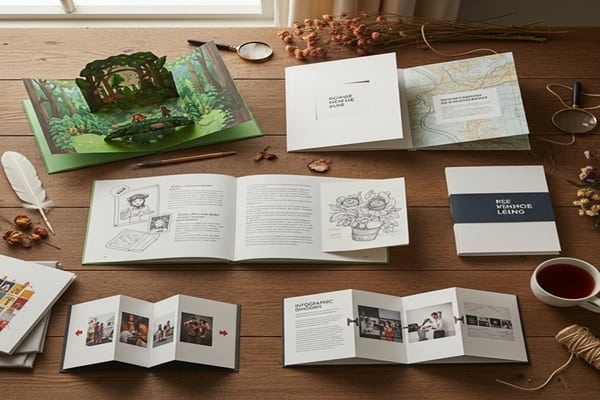Let’s be honest—we live in a world where almost everything is digital. Emails, social media ads, online catalogs—information is at our fingertips 24/7. But here’s the funny thing: in this always-connected world, something as simple as a printed booklet can feel surprisingly refreshing.
Think about it. Holding a well-designed booklet in your hands feels different than scrolling on your phone. You notice the weight of the paper, the texture of the cover, even the sound of flipping pages. It slows you down, gives you space to absorb information, and makes the message feel more real.
That’s why so many businesses, nonprofits, schools, and event organizers are rediscovering the power of booklets. Whether you’re telling your brand story, creating a product catalog, or handing out event guides, a thoughtfully designed booklet can make your message stick in ways a quick digital scroll never could.
In this guide, we’ll explore exactly why booklets are still so valuable, the creative ways you can use them, and some insider tips on designing one that people will actually keep.
Why Booklets Stand Out in the Digital Age
Here’s the truth: digital is everywhere, but it’s also overwhelming. Our inboxes are cluttered, ads follow us around, and we swipe past hundreds of messages every day.
Printed booklets cut through the noise. They feel intentional, personal, and lasting. When someone hands you a booklet—or you receive one in the mail—it doesn’t disappear in two seconds. It sits on your desk, coffee table, or nightstand, waiting for you to flip through it again.
That tangible quality makes booklets:
-
Memorable – People remember what they can physically hold.
-
Trust-building – A well-printed booklet feels credible and professional.
-
Engaging – Readers control the pace, re-reading sections as they like.
No wonder organizations are bringing them back as a core part of their communication strategy.
1. Booklets Bring Brand Stories to Life
Your brand is more than just products and services—it’s about people, values, and stories. A booklet gives you the space to go beyond a quick tagline and really connect with your audience.
Imagine a beautifully designed booklet that shares:
-
Your company’s origin story
-
Behind-the-scenes photos of your team
-
Interviews with founders or employees
-
A timeline of milestones and achievements
This isn’t just marketing—it’s storytelling. Done right, a brand booklet feels like a keepsake, something readers hang onto and revisit. Every time they do, your brand becomes a little more familiar and trusted.
2. Product Catalogs That Feel Like Experiences
Scrolling through an online shop is convenient, sure—but it’s also easy to forget. A physical catalog or lookbook, on the other hand, has staying power.
Fashion brands, tech companies, and even home décor businesses use booklets to showcase products in a way that feels curated and special. High-quality photos, paired with short descriptions, let customers step into your world.
Booklets also shine at events and trade shows. Instead of handing out a flimsy flyer, give potential customers a catalog they’ll actually want to browse later. It keeps your brand top of mind and can even spark conversations that lead to sales.
3. A Must-Have for Education and Training
Booklets aren’t just for businesses—they’re essential tools in schools, universities, and workplaces.
Think of them as learning companions. They can serve as:
-
Student handbooks
-
Curriculum guides
-
Training manuals
-
Onboarding booklets
-
Safety or compliance guides
Unlike a one-off email or presentation, a booklet is something learners can refer back to anytime. Add in visuals like diagrams, step-by-step instructions, and infographics, and suddenly complicated material becomes a lot easier to understand.
For companies, especially those with big teams, standardized training booklets ensure everyone gets the same clear, consistent information.
4. Event Guides That Double as Souvenirs
Ever been to a big conference or festival without a guide? It’s overwhelming. That’s why event booklets are game-changers.
A well-made event booklet can include:
-
Schedules and timelines
-
Speaker or performer bios
-
Venue maps
-
Sponsor shoutouts
-
Tips for making the most of the event
Not only do they help attendees navigate the day, but they also become keepsakes afterward. That booklet on someone’s shelf or desk is a reminder of your event—and your brand—for months or even years to come.
5. Building Community Connections
For nonprofits, charities, and community organizations, booklets are powerful storytelling tools.
Through photo essays, testimonials, and case studies, you can show real impact: the families helped, the neighborhoods improved, the projects completed. Instead of just telling people what you do, you show them—making it easier for readers to connect emotionally and take action.
These booklets often play a role in:
-
Annual reports
-
Fundraising campaigns
-
Volunteer recruitment
-
Grant applications
When done right, they don’t just inform—they inspire.
Also Read : Nomurano: The Rise of Mindful Aesthetics
6. Adding Interactive Elements
Here’s where booklets get really exciting. Print doesn’t have to be static anymore. By combining print with digital, you can create interactive experiences.
Some fun ideas:
-
QR codes that link to videos or product demos
-
NFC chips that unlock exclusive content
-
Augmented reality features that bring images to life
-
Fill-in sections, checklists, or journaling prompts that make booklets more personal
This hybrid approach makes your booklet not only engaging but also bridges the gap between offline and online experiences.
7. The Design Secrets Behind Effective Booklets
Okay, let’s get practical. If you’re going to invest in booklets, design matters—a lot. Here are some simple tips:
-
Consistent branding – Use your colors, fonts, and logos throughout.
-
High-quality images – Professional photos and graphics go a long way.
-
Clean layouts – Use headings, subheadings, and white space to keep it readable.
-
Calls to action – Always invite readers to take the next step (visit your site, sign up, give feedback, make a purchase).
Remember: the goal is to make your booklet easy to navigate and enjoyable to read.
8. Why Businesses Still Invest in Print
With all the hype around digital marketing, you might wonder: is print really worth it?
Here’s the thing—because print is less common these days, it actually stands out more. A beautifully designed booklet feels premium, almost like a gift. Customers notice the effort, and that builds trust and credibility.
In fact, studies show that people are more likely to remember printed material compared to digital ads. That’s huge if you’re trying to make a lasting impression.
9. How Booklets Complement Digital Marketing
This isn’t an either/or situation. The smartest organizations use print and digital together.
Example: send a product booklet by mail, but include QR codes that take readers straight to your online shop. Or hand out event booklets with links to a companion app.
This print-digital synergy gives audiences the best of both worlds—something tangible to hold plus the convenience of instant online action.
10. A Lasting Impact in Readers’ Hands
At the end of the day, booklets aren’t just about sharing information—they’re about creating an experience.
When designed thoughtfully, a booklet becomes:
-
A trusted resource (like a training manual)
-
A conversation starter (like a catalog or lookbook)
-
A memorable keepsake (like an event guide or brand story)
And unlike digital messages that vanish in seconds, booklets have a way of sticking around—on shelves, desks, and coffee tables—reminding people of your message long after they first read it.
Final Thoughts
In a digital-first world, booklets offer something rare: a personal, lasting, and meaningful connection. They slow people down, invite them to engage deeply, and give your message a physical presence that pixels can’t match.
So whether you’re a business showcasing products, a nonprofit sharing impact stories, a school creating learning guides, or an event planner designing programs—don’t underestimate the power of a well-crafted booklet.
Done right, it won’t just share information. It’ll create an experience that resonates, builds trust, and leaves a lasting impression.




